Nb and REE Distribution in the Monte Verde Carbonatite–Alkaline–Agpaitic Complex (Angola)
Abstract
1. Introduction
2. Geological Setting
3. Materials and Methods
4. Results
4.1. Monte Verde Carbonatite Structure
4.2. Petrography of the Monte Verde Units: Occurrence of Nb and REE Phases
4.2.1. Plutonic Alkaline Rocks
4.2.2. Fenitized Granites
4.2.3. Magmatic Breccia
Magmatic Breccia with an Alkaline Groundmass
- Foidolitic: which tends to be groundmass-supported, and feldspathoids (nepheline and sodalite, more or less replaced by cancrinite) are the most abundant minerals, replacing K-feldspar and albite. In addition, fluorapatite, anhedral biotite, calcite, richterite-ferrorichterite and fluornatropyrochlore occur as minor components. Pyrochlore occurs as euhedral inclusions inside all the above-mentioned minerals, suggesting its early crystallization from the melt. Nepheline appears to be associated with zircon. Cancrinite could have an important metallogenetic role, as it often appears intergrown with fluorite, calcioancylite-(Ce), burbankite, and secondary pyrochlore (Figure 4d). Late sodalite replaces albite and nepheline. A new generation of U- and Ti-rich pyrochlore is associated with sodalite and replaced earlier pyrochlore types. Because of its U content, it presents intense fracturing due to metamictization processes (Figure 4e). Rare rounded ilmenorutile is also overgrown by Mn-rich ilmenite, secondary fine-grained Na-rich-calciopyrochlore, pyrrhotite, and galena (Figure 5b, Table 2).
Breccia with Carbonatite Groundmass
4.2.4. Alkaline Dykes
4.3. Mineral Chemistry
4.3.1. Pyrochlore
Primary (Type I)
Secondary Pyrochlore (II, III, IV, V, VI Types)
4.3.2. Perovskite-Loparite-(Ce)
4.3.3. Eudialyte
4.3.4. Na-Zr-Ti Sorosilicates
- Rosenbuschite [Na6Ca6Zr3Ti(Si2O7)4] is a characteristic phase of alkaline conditions reflecting low agpaicity as its alkalinity is close to 25% [50,51]. Zr content (1.68–1.80 a.p.f.u.) is higher than that of Nb (0.96–1.04 a.p.f.u.), and Ti (0.41–0.47 a.p.f.u). In addition, Mn and Fe are also remarkable (up to 0.7 and 0.3 a.p.f.u., respectively).
- Mosandrite-(Ce) [(Ca3REE)(H2O)2Ca0.5□0.5)(Ti(Si2O7)(OH)(H2O)2] is an alkaline sorosilicate indicative of almost miaskitic conditions [52]. Ti is the main cation of high charge cations (up to 2.1 a.p.f.u.) with lesser Zr and Nb. In addition, LREE concentrations are high, especially Ce content (up to 0.91 a.p.f.u.); Y and F contents are extremely low.
- Rinkite-(Ce) [(Ca3,REE)4Na(Na,Ca)2(Ti,Zr,Nb)(Si2O7)2(O,F)2(H2O)2] usually replaces mosandrite-(Ce) and may suggest an increase of the agpaicity of the rock. Ce is the main LREE (up to 0.46 a.p.f.u.), Ti (0.81–0.96 a.p.f.u) is dominant over Nb and Zr, and F is below detection limit, as in rosenbuschite and mosandrite-(Ce).
4.3.5. REE Carbonate Group
- Monte Verde burbankite [(Na,Ca)3(Sr,Ba,Ca,REE)3(CO3)5] presents compositional variations, but Na is mostly higher than Ca. In nepheline trachyte dykes, Ce and La are the most abundant LREE (0.21–0.66 and 0.22–0.43 a.p.f.u., respectively). In addition, Ba and Sr may enter the B site reaching high proportions, locally higher than those of LREE. However, in calciocarbonatite xenoliths, burbankite is a trace phase with lower REE and Ba but higher Sr.
- Carbocernaite [(Ca,Na)(Sr,Ce,Ba)(CO3)2] is a secondary phase, usually replacing burbankite in nepheline trachyte dykes. Ca contents are higher than Na, and Sr may also be high (up to 0.86 a.p.f.u.). Minor Ba and REE have also been recorded. Ce and La only reach up to 0.16 and 0.12 a.p.f.u., respectively.
- Ancylite-(Ce)-calcioancylite-(Ce) [(Ca,Sr)2−xREEx(CO3)2(OH)x(2−x)H2O] correspond to the most abundant REE carbonates of the Monte Verde complex. They often replace earlier REE carbonates generally associated with strontianite and barite. In the nepheline trachyte dykes, ancylite-(Ce) intergrows late calcite and albite, although it can also replace Na-Zr silicates along with titanite and ilmenorutile. Ce contents are about 0.74 a.p.f.u., whereas La and Nd are lower. On the other hand, in calciocarbonatite xenoliths, ancylite-(Ce) exhibits a similar composition but higher ThO2 contents, which may reach up to 4.79 wt.%.
- Synchysite-(Ce) [Ca3(LREE)2(CO3)(F,OH)3] forms acicular aggregates overgrowing strontianite, barite, and galena. The previous association replaces the alkaline groundmass of nepheline trachyte dykes. High Ce, La, Nd, and Pr are dominant, with Ce and La as the most important cations reaching up to 1.69 and 0.95 a.p.f.u., respectively. As indicated in the ancylite crystals, ThO2 may reach up to 3.24 wt.%. The X-site is fully occupied by OH; therefore, synchysite must correspond to a theoretical hydroxylsynchysite-(Ce), although this phase has not been characterized yet.
- Extremely rare REE minerals were identified replacing nepheline in trachyte dykes. Remondite [Na3(REE)3(CO3)5] is associated with late calcite, both phases filling fine veins. LREE show high contents, but no HREE have been detected. In addition, a similar phase to kukharenkoite-(Ce) [Ba4 (LREE)2(CO3)6F2] is associated with hydroxylsynchysite-(Ce), strontianite, and barite, and presents higher Ba contents and Ce as the dominant LREE cation (up to 1.34 a.p.f.u).
4.3.6. REE Silicates and Phosphates
- Britholite-(Ce) [Ca,REE)10(Si,PO4)6(OH,F)2] occurs in nepheline trachyte dykes associated with late albite overgrowing nepheline-, sanidine-rich groundmass. Britholite presents up to 5.07 a.p.f.u. Si, whereas Ce and La are the most common LREE cations (up to 2.19 and 1.64 a.p.f.u, respectively). F contents are low (0.2–0.3 a.p.f.u.), which is also the case of Na-Zr-Ti sorosilicates and REE carbonates of Monte Verde.
- Rhabdophane-(Ce) and raphdophane-(La) [(REE,Ca,Th)(PO)4·H2O] are found in association with quartz veins replacing fenitized granites. They present Ce and La enrichments (up to 0.62 and 0.50 a.p.f.u., respectively) with lesser Nd—which is slightly higher in rhabdophane-(La). Th and HREE are negligible.
5. Discussion
5.1. Evolution of the Monte Verde Complex
5.2. Pyrochlore Evolution in Monte Verde
5.3. Metallogenetic Potential of the Monte Verde Carbonatites
5.4. Metallogenetic Potential of Alkaline Rocks of Monte Verde
6. Conclusions
Supplementary Materials
Author Contributions
Funding
Acknowledgments
Conflicts of Interest
References
- Nielsen, T.F.D. The petrology of a melilitolite, melteigite, carbonatite and syenite ring dike system, in the Gardiner complex, East Greenland. Lithos 1980, 13, 181–197. [Google Scholar] [CrossRef]
- Kogarko, L.N.; Kononova, V.A.; Orlova, M.P.; Wooley, A.R. Alkaline Rocks and Carbonatites of the World; Chapman and Hall: London, UK, 1995; pp. 1–226. [Google Scholar]
- Mariano, A.N. Economic Geology of Rare Earth Minerals. In Geochemistry and Mineralogy of Rare Earth Elements; Lipman, B.R., KcKay, G.A., Eds.; Mineralogical Society of America: Chantilly, VA, USA, 1989; Volume 21, pp. 303–337. [Google Scholar]
- Steenfelt, A. High-technology metals in alkaline and carbonatitic rocks in Greenland: Recognition and exploration. J Geochem. Explor. 1991, 40, 263–279. [Google Scholar] [CrossRef]
- Sørensen, H. Agpaitic nepheline syenites: A potential source of rare elements. Appl. Geochem. 1992, 7, 417–427. [Google Scholar] [CrossRef]
- Pell, J. Mineral deposits associated with carbonatites and related alkaline igneous rocks. In Undersaturated Alkaline Rocks: Mineralogy, Petrogenesis and Economic Potential; Mitchell, R.H., Ed.; Mineralogical Association of Canada: Québec, QC, Canada, 1996; Volume 24, pp. 271–310. [Google Scholar]
- Sørensen, H. The Ilímaussaq Alkaline Complex, South Greenland—An Overview of 200 years of research and outlook. Contribution to the mineralogy of Ilímaussaq no. 130. Medd. Grønland Greenl. Geosci. 2006, 45, 1–70. [Google Scholar]
- Woolley, A.R. Alkaline Rocks and Carbonatites of the World; Geological Society of London: London, UK, 2001; pp. 1–372. [Google Scholar]
- Arzamastsev, A.A.; Bea, F.; Arzamastseva, L.V.; Montero, P. Rare earth elements in rocks and minerals from alkaline plutons of the Kola Peninsula, NW Russia, as indicators of alkaline magma evolution. Rus. J. Earth Sci. 2002, 4, 187–209. [Google Scholar] [CrossRef]
- Arzamastsev, A.A.; Yakovenchuk, V.; Pakhomovsky, Y.; Ivanyuk, G. The Khibina and Lovozero alkaline massifs: Geology and unique mineralization. In Guidebook 33 IGC Excursion; IUGS: Oslo, Norway, 2008; Volume 47, p. 58. [Google Scholar]
- Arzamastsev, A.A.; Arzamastseva, L.V.; Zhirova, A.M.; Glaznev, V.N. Model of formation of the Khibiny-Lovozero ore bearing volcanic-plutonic complex. Geol. Ore Depos. 2013, 55, 341–356. [Google Scholar] [CrossRef]
- Chakhmouradian, A.R.; Zaitsev, A.N. Rare earth mineralization in igneous rocks: Sources and processes. Elements 2012, 8, 347–353. [Google Scholar] [CrossRef]
- Chakhmouradian, A.R.; Wall, F. Rare earth elements: Minerals, mines, magnets (and more). Elements 2012, 8, 333–340. [Google Scholar] [CrossRef]
- Smith, M.P.; Moore, K.; Kavecsánszki, D.; Finch, A.A.; Kynicky, J.; Wall, F. From mantle to critical zone: A review of large and giant-sized deposits of the rare earth elements. Geosci. Front. 2016, 7, 315–334. [Google Scholar] [CrossRef]
- Goodenough, K.M.; Schilling, J.; Jonsson, E.; Kalvig, P.; Charles, N.; Tuduri, J.; Deady, E.A.; Sadeghi, M.; Schiellerup, H.; Müller, A.; et al. Europe’s rare earth element resource potential: An overview of REE metallogenetic provinces and their geodynamic setting. Ore Geol. Rev. 2016, 72, 838–856. [Google Scholar] [CrossRef]
- Dostal, J. Rare earth element deposits of alkaline igneous rocks. Resources 2017, 6, 34. [Google Scholar] [CrossRef]
- Chakhmouradian, A.R.; Mitchell, R.H. Primary, agpaitic and deuteric stages in the evolution of accessory Sr, REE, Ba and Nb-mineralization in nepheline-syenite pegmatites at Pegmatite Peak, Bearpaw Mts, Montana. Mineral. Petrol. 1999, 67, 85–110. [Google Scholar] [CrossRef]
- Markl, G. Stability of Na–Be minerals in late-magmatic fluids of the Ilímaussaq alkaline complex, South Greenland. Geol. Surv. Den. Greenl. 2001, 190, 145–158. [Google Scholar]
- Barton, M.D.; Young, S. Non-pegmatitic deposits of beryllium-Mineralogy, geology, phase equilibria and origin. Rev. Mineral. Geochem. 2002, 50, 591–691. [Google Scholar] [CrossRef]
- Foley, N.K.; Jaskula, B.W.; Piatak, N.M.; Schulte, R.F. Critical Mineral Resources of the United States-Economic and Environmental Geology and Prospects for Future Supply; Schulz, K.J., DeYoung, J.H., Jr., Seal, R.R., II, Bradley, D.C., Eds.; U.S. Geological Survey: Reston, VA, USA, 2017; pp. E1–E32.
- Lyalina, L.M.; Selivanova, E.A.; Zozulya, D.R.; Ivanyuk, G.Y. Beryllium mineralogy of the Kola Peninsula, Russia—a review. Minerals 2019, 9, 12. [Google Scholar] [CrossRef]
- Mitchell, R.H. Carbonatites and carbonatites and carbonatites. Can. Mineral. 2005, 43, 2049–2068. [Google Scholar] [CrossRef]
- Lapido-Loureiro, F.E.V. Carbonatitos de Angola. Memórias Trab. Inst. Investig. Científica Angola 1973, 11, 1–242. [Google Scholar]
- Issa Filho, A.; Dos Santos, A.B.R.M.D.; Riffel, B.F.; Lapido-Loureiro, F.E.V.; McReath, I. Aspects of the geology, petrology and chemistry of some Angolan carbonatites. J. Geochem Explor. 1991, 40, 205–206. [Google Scholar] [CrossRef]
- Bambi, A.J.M.; Costanzo, A.; Gonçalves, A.O.; Melgarejo Draper, J.C. Tracing chemical evolution of primary pyrochlore from plutonic to volcanic carbonatites: The role of F. Mineral. Mag. 2012, 76, 377–392. [Google Scholar] [CrossRef]
- Bambi, A.J.M. Metalogenia de Las Carbonatitas en Dominios Plutónicos, Subvolcánicos y Volcánicos: Tchivira, Bonga y Catanda, Angola. Ph.D. Thesis, Universitat de Barcelona, Barcelona, Spain, November 2015. [Google Scholar]
- Zheng, L.; Gu, X.; Zhang, Y. Pyrochlore chemistry from the Bonga carbonatite type Nb deposit, Huila Province, Angola: Implications for magmatic-processes of carbonatite. Acta Geol. Sin. 2014, 2, 487–488. [Google Scholar] [CrossRef]
- Amores, S. Evolución Metalogenética de Complejos Carbonatíticos en Contexto Hipoabisal y Plutónico: Bonga y Monte Verde (Angola). Ph.D. Thesis, Universitat de Barcelona, Barcelona, Spain, September 2017. [Google Scholar]
- Amores-Casals, S.; Melgarejo, J.C.; Bambi, A.C.J.M.; Gonçalves, A.O.; Morais, E.; Manuel, J.; Costanzo, A.; Martí Molist, J. Lamprophyre—Carbonatite magma mingling and subsolidus processes as key controls on critical elements enrichment in carbonatites: The Bonga complex (Angola). Minerals 2019, 9, 601. [Google Scholar] [CrossRef]
- Melgarejo, J.C.; Costanzo, A.; Bambi, A.C.J.M.; Gonçalves, A.O.; Neto, B.N. Subsolidus processes as a key factor on the distribution of Nb species in plutonic carbonatites: The Tchivira case, Angola. Lithos 2012, 152, 187–201. [Google Scholar] [CrossRef]
- Torró, L.; Villanova, C.; Castillo, M.; Campeny, M.; Gonçalves, A.O.; Melgarejo, J.C. Niobium and rare earth minerals from the Virulundo carbonatite, Namibe, Angola. Mineral. Mag. 2012, 76, 393–409. [Google Scholar] [CrossRef]
- Castellano, A.; Melgarejo, J.C.; Bambi, A.C.J.M.; Gonçalves, A.O.; Alfonso, P. Nb and REE at the Bailundo carbonatite, Angola. In Let’s Talk Ore Deposits; Barra, F., Ed.; Universidad Católica del Norte: Antofagasta, Chile, 2011; pp. 675–677. [Google Scholar]
- Campeny, M. Caracterización del Vulcanismo Carbonatítico de Catanda. Ph.D. Thesis, Universitat de Barcelona, Barcelona, Spain, November 2015. [Google Scholar]
- Alberti, A.; Castorina, F.; Censi, P.; Comin-Chiaramonti, P.; Gomes, C.B. Geochemical characteristics of Cretaceous carbonatites from Angola. J. Afr. Earth Sci. 1999, 29, 735–759. [Google Scholar] [CrossRef]
- Comin-Chiaramonti, P.; Barros Gomes, C.; Cundari, A.; Castorina, F.; Censi, P. A review of carbonatitic magmatism in the Paraná-Angola-Namibia (PAN) system. Period. Mineral. 2007, 76, 25–78. [Google Scholar]
- Pereira, E.; Rodrigues, J.; Reis, B. Synopsis of Lunda geology, NE Angola: Implications for diamond explorations. Comun. Inst. Geol. Mineiro 2003, 90, 189–212. [Google Scholar]
- Robles-Cruz, S.E.; Escayola, M.; Jackson, S.; Galí, S.; Pervov, V.; Watangua, M.; Gonçalves, A.; Melgarejo, J.C. U-Pb SHRIMP geochronology of zircon from the Catoca kimberlite, Angola. Implication for diamond exploration. Chem. Geol. 2012, 310–311, 137–147. [Google Scholar] [CrossRef]
- Castillo-Oliver, M.; Galí, S.; Melgarejo, J.C.; Griffin, W.L.; Belousova, E.; Pearson, N.J.; Watangua, M.; O’Reilly, S.Y. Trace-element geochemistry and U – Pb dating of perovskite in kimberlites of the Lunda Norte Province (NE Angola): Petrogenetic and tectonic implications. Chem. Geol. 2016, 426, 118–134. [Google Scholar] [CrossRef]
- Giuliani, A.; Campeny, M.; Kamenetsky, V.; Alfonso, J.C.; Maas, R.; Melgarejo, J.C.; Kohn, B.P.; Matchan, E.L.; Mangas, J.; Gonçalves, A.O.; et al. Southwestern Africa on the burner: Pleistocene carbonatite volcanism linked to deep mantle upwelling in Angola. Geology 2017, 45, 971–974. [Google Scholar] [CrossRef]
- Morogan, V.; Woolley, A.R. Fenitization at the Alnö carbonatite complex, Sweden; distribution, mineralogy and genesis. Contrib. Mineral. Petrol. 1988, 100, 169–182. [Google Scholar] [CrossRef]
- Le Bas, M.J. Fenites associated with carbonatites. Can. Mineral. 2008, 46, 915–932. [Google Scholar] [CrossRef]
- Atencio, D.; Andrade, M.B.; Christy, A.G.; Gieré, R.; Kartashov, P.M. The pyrochlore supergroup of minerals: Nomenclature. Can. Mineral. 2010, 48, 673–698. [Google Scholar] [CrossRef]
- Lumpkin, G.R.; Ewing, R.C. Geochemical alteration of pyrochlore group minerals: Pyrochlore subgroup. Am. Mineral. 1995, 80, 732–743. [Google Scholar] [CrossRef]
- Chakhmouradian, A.R.; Mitchell, R.H. Compositional variation of perovskite-group minerals from the Khibina complex, Kola peninsula, Russia. Can. Mineral. 1998, 36, 953–969. [Google Scholar]
- Mitchell, R.H.; Welch, M.D.; Chakhmouradian, A.R. Nomenclature of the perovskite supergroup: A hierarchical system of classification based on crystal structure and composition. Mineral. Mag. 2017, 81, 411–461. [Google Scholar] [CrossRef]
- Shibayeva, R.I.; Belov, N.V. Crystal structure of wöhlerite, Ca2Na(Zr,Nb)Si2O7(O,F)2. Dokl. Akad. Nauk SSSR 1960, 146, 897–900. [Google Scholar]
- Bellezza, M.; Merlino, S.; Perchiazzi, N. Chemical and structural study of te Zr, Ti-disilicates in the venanzite from Pian di Celle, Umbria, Italy. Eur. J. Mineral. 2004, 16, 957–969. [Google Scholar] [CrossRef]
- Biagioni, C.; Merlino, S.; Parodi, G.C.; Perchiazzi, N. Crystal chemistry of minerals of the wöhlerite group from the Los archipelago, Guinea. Can. Mineral. 2012, 50, 593–609. [Google Scholar] [CrossRef]
- Mariano, A.N.; Roeder, P.L. Wöhlerite: Chemical composition, cathodolumniscence and environment of crystallization. Can. Mineral. 1989, 27, 709–720. [Google Scholar]
- Vlasov, K.A. Geochemistry and mineralogy of rare elements and genetic types of their deposits. In Geochemistry of Rare Elements; Vlasov, K.A., Ed.; Israel Program for Scientific Translations: Jerusalem, Israel, 1966; Volume 1, p. 688. [Google Scholar]
- Mitchell, R.H.; Chakhmouradian, A.R. Compositional variation of loparite from the Lovozero alkaline complex, Russia. Can. Mineral. 1996, 34, 977–990. [Google Scholar]
- Christiansen, C.; Johnsen, O.; Makovicky, E. Crystal chemistry of rosenbuschite group. Can. Mineral. 2003, 41, 1203–1224. [Google Scholar] [CrossRef]
- Schilling, J.; Wu, F.Y.; McCammon, C.; Wenzel, T.; Marks, M.A.W.; Pfaff, K.; Jacob, D.E.; Markl, G. The compositional variability of eudialyte group minerals. Mineral. Mag. 2011, 75, 87–115. [Google Scholar] [CrossRef]
- Chakrabarty, A.; Pruseth, K.L.; Sen, A.K. Composition and Petrogenetic significance of the Eudialyte group minerals from Sushina, Purulia, West Bengal. J. Geol. Soc. India 2012, 79, 449–459. [Google Scholar] [CrossRef]
- Dawson, J.B.; Smith, J.V.; Steele, I.M. 1966 ash eruption of the carbonatite volcano Oldoinyo Lengai: Mineralogy of lapilli and mixing of silicate and carbonate magmas. Mineral. Mag. 1992, 56, 1–16. [Google Scholar] [CrossRef]
- Stoppa, F.; Pirajno, F.; Schiazza, M.; Vladykin, N.V. State of art: Italian carbonatites and their potential for critical metal deposits. Gondwana Res. 2016, 37, 152–171. [Google Scholar] [CrossRef]
- Stoppa, F.; Schiazza, M.; Rosatelli, G.; Castorina, F.; Sharygin, V.V.; Ambrosio, F.A.; Vicentini, N. Italian carbonatite system: From Mantle to ore-deposits. Ore Geol. Rev. 2019, 114, 103041. [Google Scholar] [CrossRef]
- Chakhmouradian, A.; Reguir, E.; Couëslan, C.; Yang, P. Calcite and dolomite in intrusive carbonatites. II. Trace-element variations. Mineral. Petrol. 2016, 110, 361–377. [Google Scholar] [CrossRef]
- Lee, M.J.; Lee, J.I.; Garcia, D.; Moutte, J.; Williams, T.; Wall, F.; Kim, Y. Pyrochlore chemistry from the Sokli phoscorite-carbonatite complex, Finland: Implications for the genesis of phoscorite and carbonatite association. Geochem. J. 2006, 40, 1–13. [Google Scholar] [CrossRef]
- Andersson, M.; Malehmir, A.; Troll, V.R.; Dehghannejad, M.; Juhlin, C.; Ask, M. Carbonatite ring-complexes explained by caldera-style volcanism. Sci. Rep. 2013, 3, 1677. [Google Scholar] [CrossRef]
- Secher, K.; Larsen, L.M. Geology and mineralogy of the Sarfartôq carbonatite complex, southern West Greenland. Lithos 1980, 13, 199–212. [Google Scholar] [CrossRef]
- Hoover, D.B. Geophysical model of carbonatites. In The Geophysical Expression of Selected Mineral Deposit Models; Hoover, D.B., Heran, W.D., Hill, P.L., Eds.; U.S. Geological Survey: Reston, VA, USA, 1992; pp. 80–84. [Google Scholar]
- Gunn, P.J.; Dentith, M.C. Magnetic responses associated with mineral deposits. AGSO J. Aust. Geol. Geophys. 1997, 17, 145–158. [Google Scholar]
- Duncan, R.K.; Willett, G.C. Mount Weld carbonatite. In Geology of the Mineral Deposits of Australia and Papua New Guinea; Hughes, E.E., Ed.; Australasian Institute of Mining and Metallurgy: Carlton, Australia, 1990; Volume 14, pp. 591–597. [Google Scholar]
- Alva-Valdivia, L.M.; López-Loera, H. A review of iron oxide transformations, rock magnetism and interpretation of magnetic anomalies: El Morro Mine (Brazil), a case study. Geofis. Int. 2011, 50, 341–362. [Google Scholar]
- Drenth, B.J. Geophysical expression of a buried niobium and rare earth element deposit: The Elk Creek carbonatite, Nebraska, USA. Interpretation 2014, 2, SJ23–SJ33. [Google Scholar] [CrossRef]
- Andersson, M.; Malehmir, A. Unravelling the internal architecture of the Alnö alkaline and carbonatite complex (central Sweden) using 3D models of gravity and magnetic data. Solid Earth Discuss 2017, 1–35. [Google Scholar] [CrossRef]
- Li, M.; Zhou, X.; Gammons, C.H.; Khalil, M.; Speece, M. Aeromagnetic and spectral expressions of rare earth element depositsin Gallinas Mountains area, Central New Mexico, USA Interpretation. Explor. Geophys. Assoc. Petr. Geol. Mem. 2018, 6, 1–13. [Google Scholar]
- Maurya, A.K.; Dwivedi, A.K.; Mohan, R.; Kumar, A.; Panda, A. Geophysical modeling of heliborne magnetic and TEM data of Beldih alkaline-carbonatite complex, Nort Singhbhum shear zone, India: Implication for uranium-REE exploration. Explor. Res. At. Miner. 2019, 27, 99–113. [Google Scholar]
- Néron, A.; Bédard, L.P.; Gaboury, D. The Saint-Honoré carbonatite REE zone, Québec, Canada: Combined magmatic and hydrothermal processes. Minerals 2018, 8, 397. [Google Scholar] [CrossRef]
- Simonetti, A.; Bell, K.; Viladkar, S.G. Isotopic data from the Amba Dongar Carbonatite Complex, west-central India: Evidence for an enriched mantle source. Chem. Geol. 1995, 122, 185–198. [Google Scholar] [CrossRef]
- Doroshkevich, A.G.; Viladkar, S.G.; Ripp, G.S.; Burtseva, M.V. Hydrothermal REE mineralization in the Amba Dongar carbonatite complex, Gujarat, India. Can. Mineral. 2009, 47, 1105–1116. [Google Scholar] [CrossRef]
- Viladkar, S.; Magna, T.; Rapprich, V.; Hopp, J.; Čejková, B. Nb-V-enriched sövites of the northeastern and eastern part of the Amba Dongar carbonatite ring dike, India. Geochemistry 2019, in press. [Google Scholar]
- Liu, Y.; Chakhmouradian, A.R.; Hou, Z.Q.; Song, W.L.; Kynický, J. Development of REE mineralization in the giant Maoniuping deposit (Sichuan, China): Insights from mineralogy, fluid inclusions, and trace-element geochemistry. Miner. Depos. 2018, 54, 701–718. [Google Scholar] [CrossRef]
- Guo, D.X.; Liu, Y. Occurrence and geochemistry of bastnäsite in carbonatite-related REE deposits, Mianning-Dechang REE belt, Sichuan Province, SW China. Ore Geol. Rev. 2019, 107, 266–282. [Google Scholar] [CrossRef]
- Zheng, X.; Liu, Y. Mechanisms of element precipitation in carbonatite-related rare earth element deposits: Evidence from fluid inclusions in the Maoniuping deposit, Sichuan Province, southwestern China. Ore Geol. Rev. 2019, 107, 218–238. [Google Scholar] [CrossRef]
- Nadeau, O.; Cayer, A.; Pelletier, M.; Stevenson, R.; Jébrak, M. The paleoproterozoic Montviel carbonatite-hosted REE-Nb deposit, Abitibi, Canada: Geology, mineralogy, geochemistry and genesis. Ore Geol. Rev. 2015, 67, 314–335. [Google Scholar] [CrossRef]
- Nadeau, O.; Stevenson, R.; Jébrak, M. Evolution of Montviel alkaline–carbonatite complex by coupled fractional crystallization, fluid mixing and metasomatism—Part II: Trace element and Sm-Nd isotope geochemistry of metasomatic rocks: Implication for REE-Nb mineralization. Ore Geol. Rev. 2016, 72, 1163–1173. [Google Scholar] [CrossRef]
- Edahbi, M.; Plante, B.; Benzaazoua, M.; Pelletier, M. Geochemistry of rare earth elements within waste rocks from the Montviel carbonatite deposit, Quebec, Canada. Environ. Sci. Pollut. Res. 2018, 25, 10997–11010. [Google Scholar] [CrossRef] [PubMed]
- Edahbi, M.; Plante, B.; Benzaazoua, M.; Kormos, L.; Pelleter, M. Rare earth elements (La, Ce, Pr, Nd and Sm) from a carbonatite deposit: Mineralogical charcterization and geochical behavior. Minerals 2018, 8, 55. [Google Scholar] [CrossRef]
- Martí, J.; Geyer, A.; Folch, A.; Gottsmann, J. A review on collapse caldera modelling. In Caldera Volcanism: Analysis, Modelling and Response; Gottsmann, J., Martí, J., Eds.; Elsevier: Amsterdam, The Netherlands, 2008; pp. 233–283. [Google Scholar]
- Kampunzu, A.; Mohr, P. Magmatic evolution and petrogenesis in the East African Rift system. In Magmatism in Extensional Settings, the Phanerozoic African Plate; Kampunzu, A.B., Lubala, R.T., Eds.; Springer: Berlin, Germany, 1991; pp. 85–136. [Google Scholar]
- Le Maitre, R.W.; Streckeisen, A.; Zanettin, B.; Le Bas, M.J.; Bonin, B.; Bateman, P.; Bellieni, G.; Dudek, A.; Efremova, S.; Keller, J.; et al. Recommendations of the International Union of Geological Sciences Subcommission on the Systematics of Igneous Rocks. In Igneous Rocks: A Classification and Glossary of Terms; Le Maitre, R.W., Ed.; University of Tasmania: Hobart, Australia, 2003; p. 250. [Google Scholar]
- Dudkin, O.B. Asociaciones minerales agpaíticas. In Atlas De Asociaciones Minerales En Lámina Delgada; Melgarejo, J.C., Ed.; Edicions UB: Barcelona, Spain, 1997; pp. 153–160. [Google Scholar]
- Marks, M.A.W.; Markl, G. A global review on agpaitic rocks. Earth Sci. Rev. 2017, 173, 229–258. [Google Scholar] [CrossRef]
- Kogarko, L.N.; Williams, C.T.; Woolley, A.R. Chemical evolution and petrogenetic implications of loparite in the layered, agpaitic Lovozero complex, Kola Peninsula, Russia. Mineral. Petrol. 2002, 74, 1–24. [Google Scholar]
- Khomyakov, A.P. Mineralogy of Hyperagpaitic Alkaline Rocks; Clarendon Press: Oxford, UK, 1995; p. 223. [Google Scholar]
- Karup-Møller, S.; Rose-Hansen, J. New data on eudialyte decomposition minerals from kakortokites and associated pegmatites of the Illimaussaq complex, South Greenland. Bull. Geol. Soc. Den. 2013, 61, 47–70. [Google Scholar]
- Johnsen, O.; Gault, R.A. Chemical variation in eudialyte. Neues Jahrb. Mineral. Abh. 1997, 171, 215–231. [Google Scholar]
- Harris, C.; Cressey, G.; Bell, J.D.; Atkins, F.B.; Beswetherick, S. An occurrence of rare-earth-rich eudialyte from Ascension Island, South Atlantic. Mineral. Mag. 1982, 46, 421–425. [Google Scholar] [CrossRef]
- Olivo, G.R.; Williams-Jones, A.E. REE-rich eudialyte from the Pilanesberg complex, South Africa. Can. Mineral. 1999, 37, 653–663. [Google Scholar]
- Sokolova, E.; Cámara, F. The seidozerite supergroup of TS-block minerals: Nomenclature and classification, with change of the following names: Rinkite to rinkite-(Ce), mosandrite to mosandrite-(Ce), hainite to hainite-(Y) and innelite-1T to innelite-1A. Mineral. Mag. 2017, 81, 1457–1484. [Google Scholar] [CrossRef]
- Migdisov, A.A.; Williams-Jones, A.E. A spectrophotometric study of neodymium (III) complexation in chloride solutions. Geochim. Cosmochim. Acta 2002, 66, 4311–4323. [Google Scholar] [CrossRef]
- Salvi, S.; Williams-Jones, A.E. Alkaline granite-syenite deposits. In Rare Element Geochemistry and Mineral Deposits; Linnen, R.L., Samson, I.M., Eds.; Geological Association of Canada: St. John’s, NL, Canada, 2015; pp. 315–341. [Google Scholar]
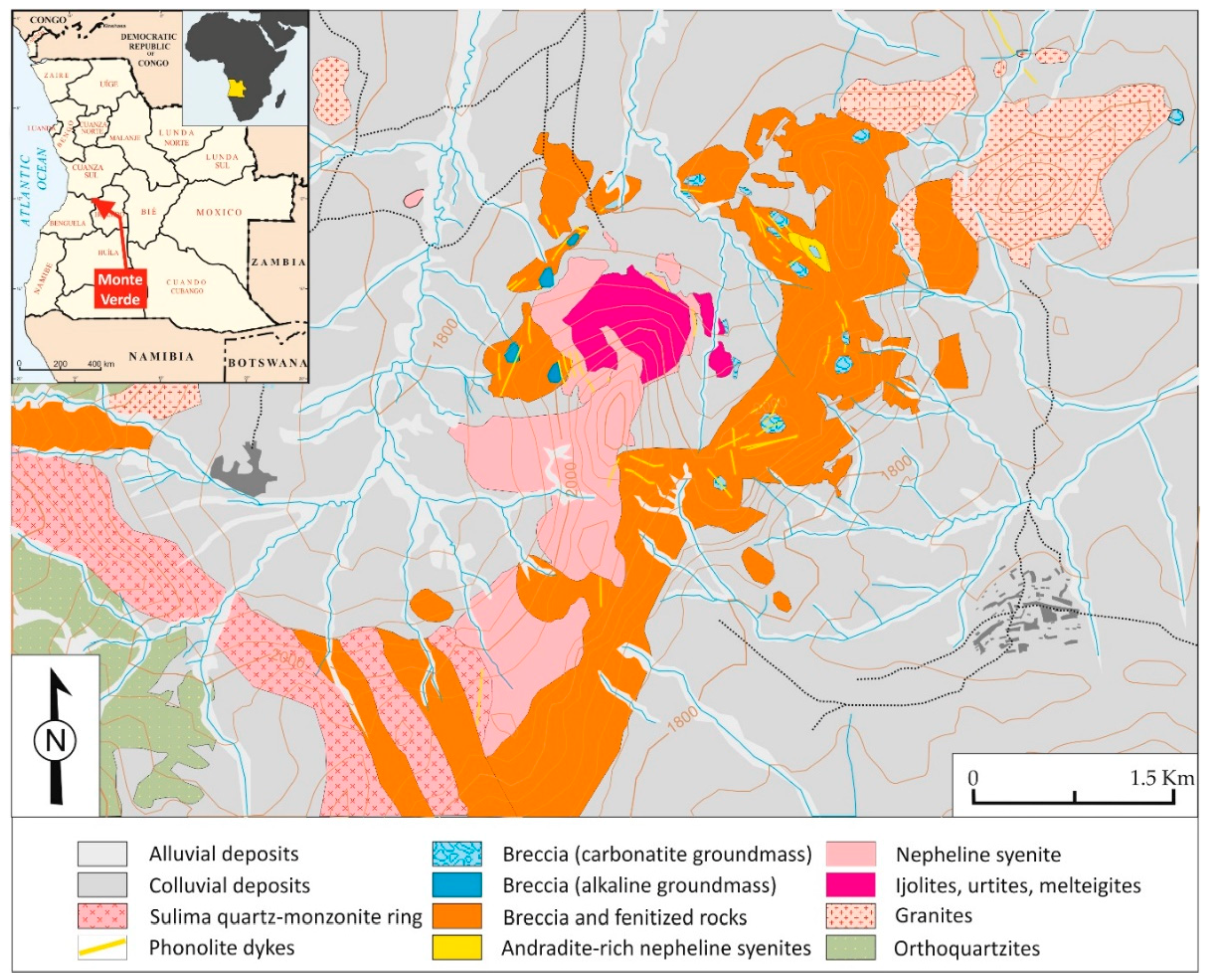
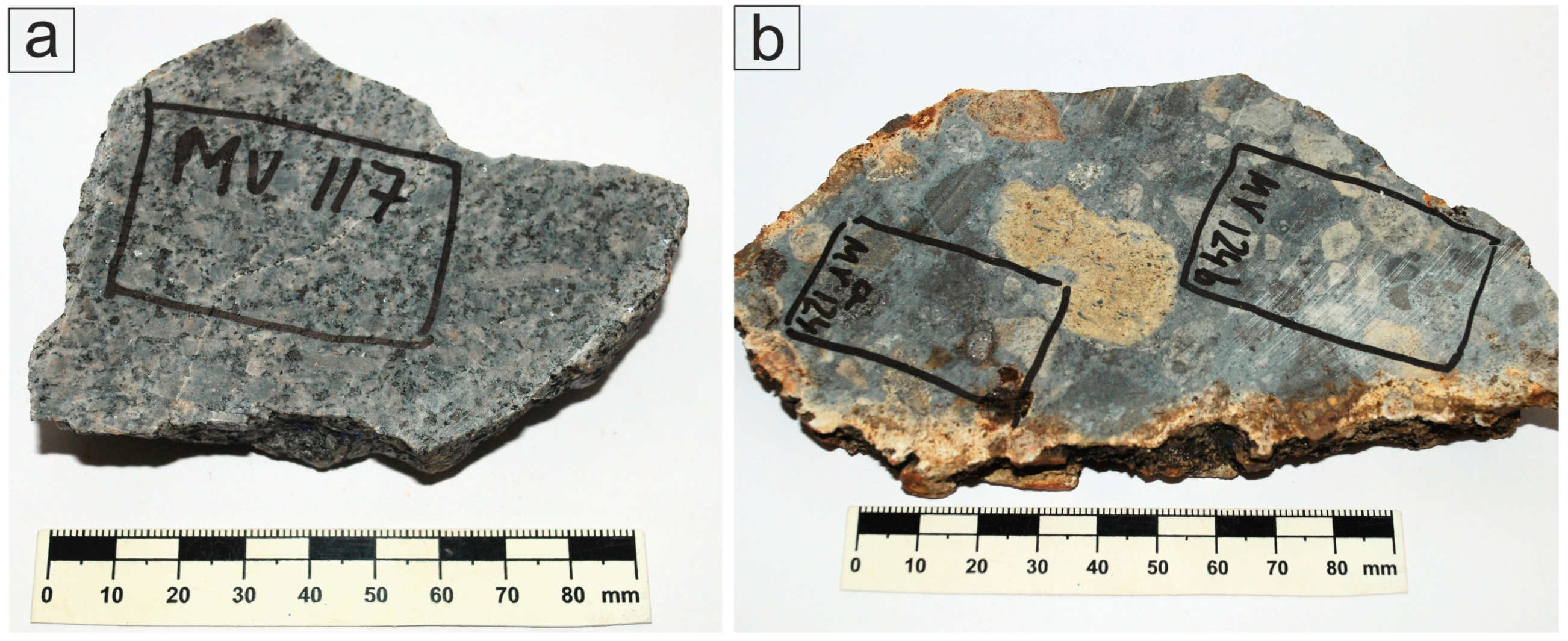
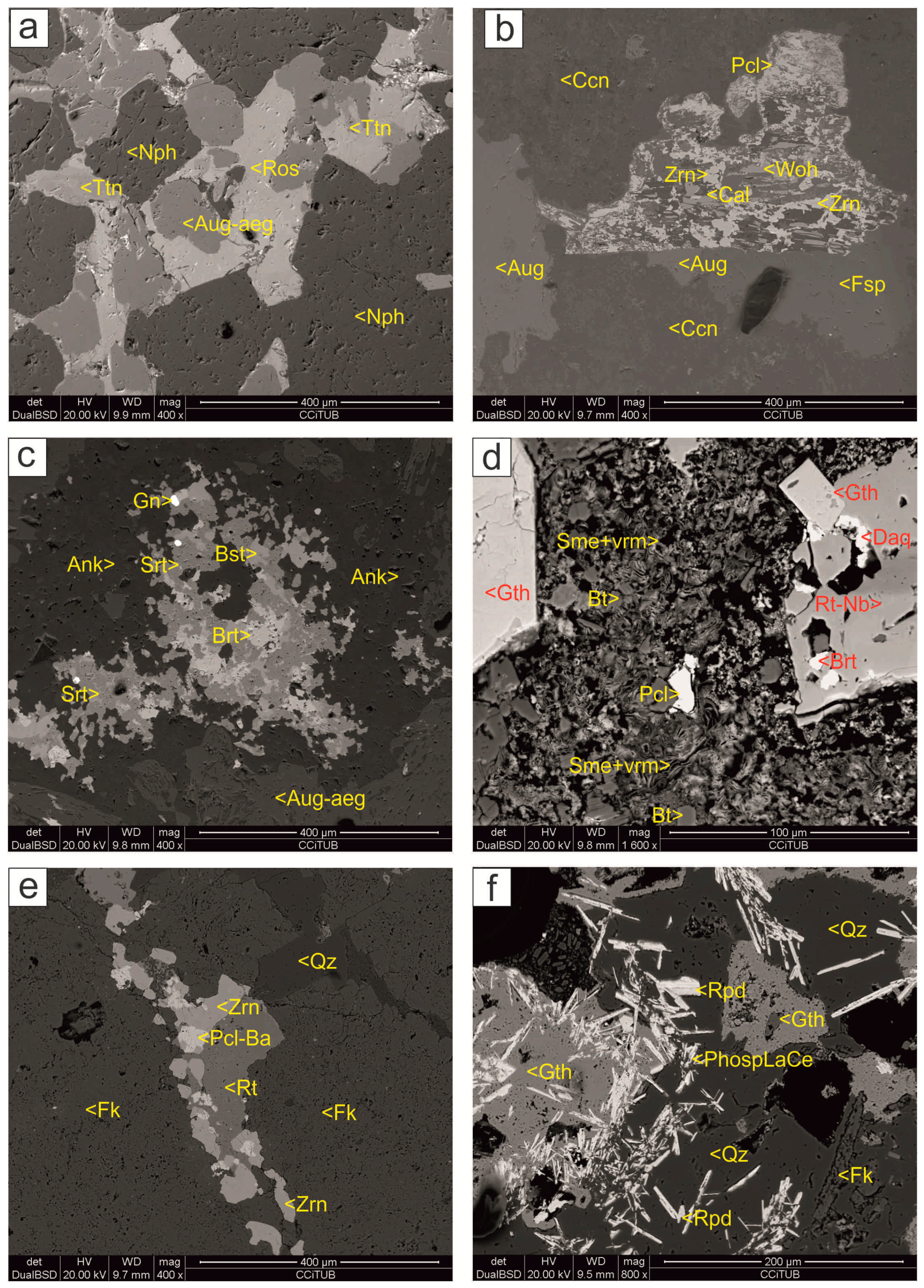
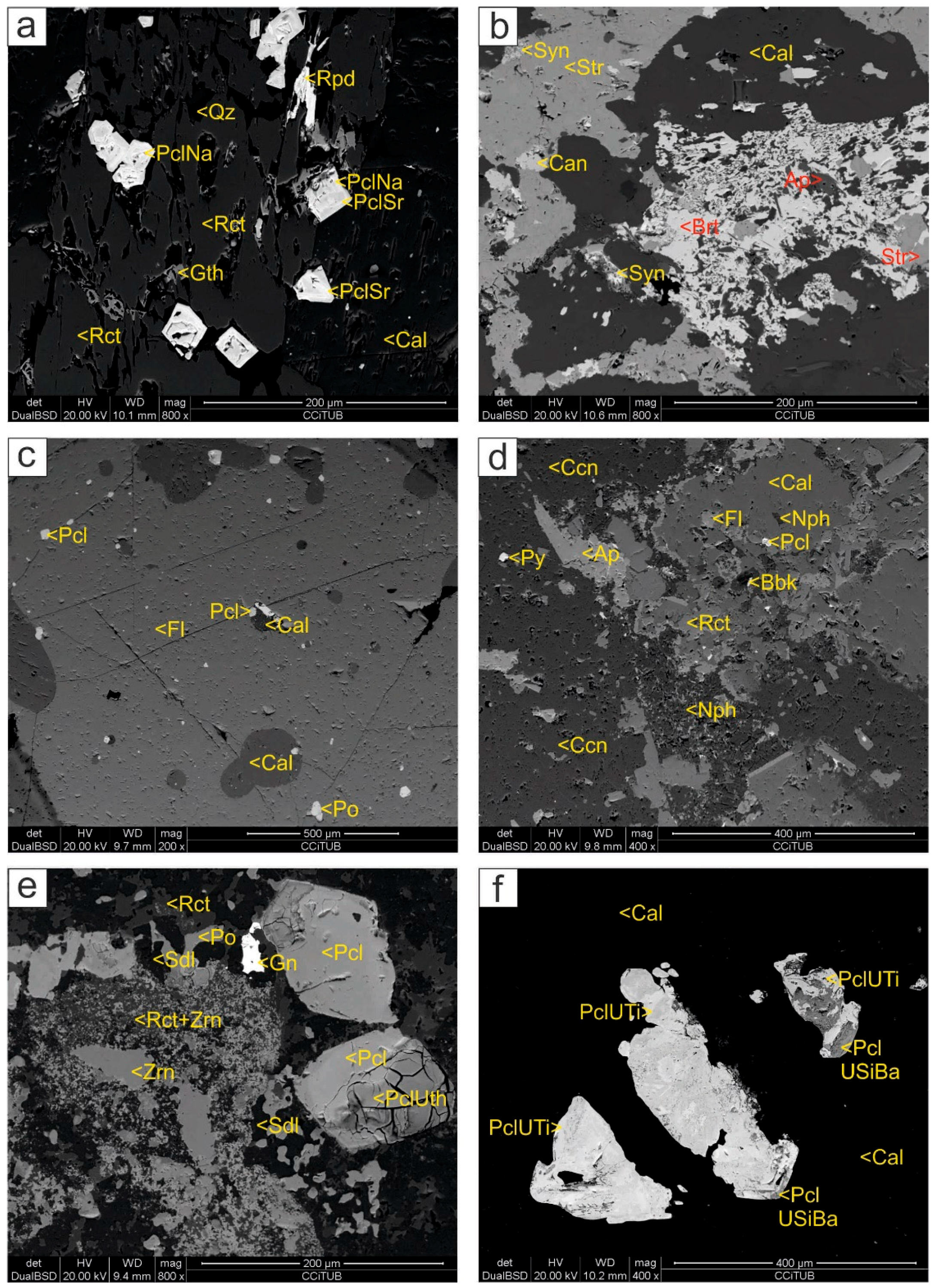
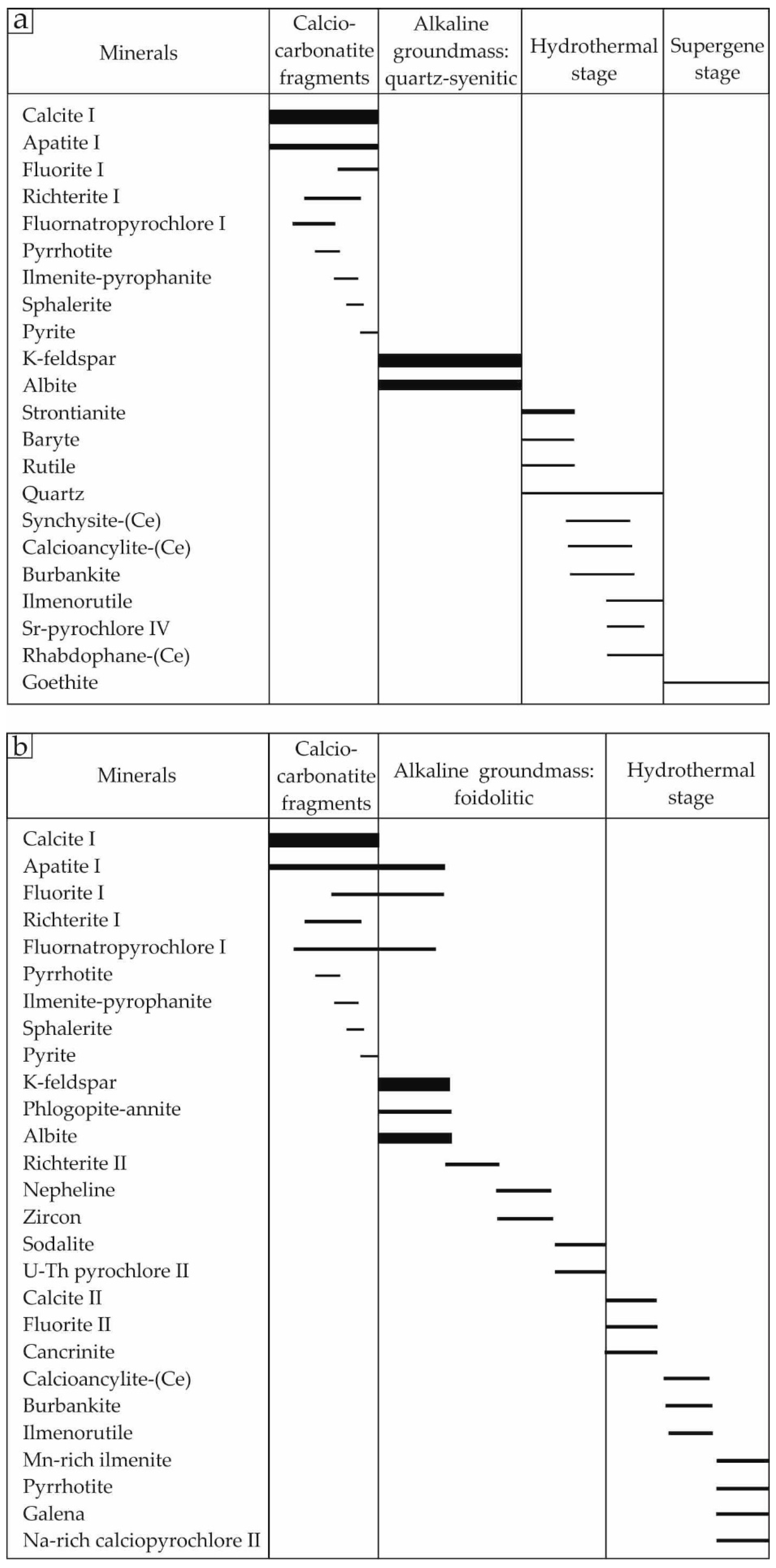
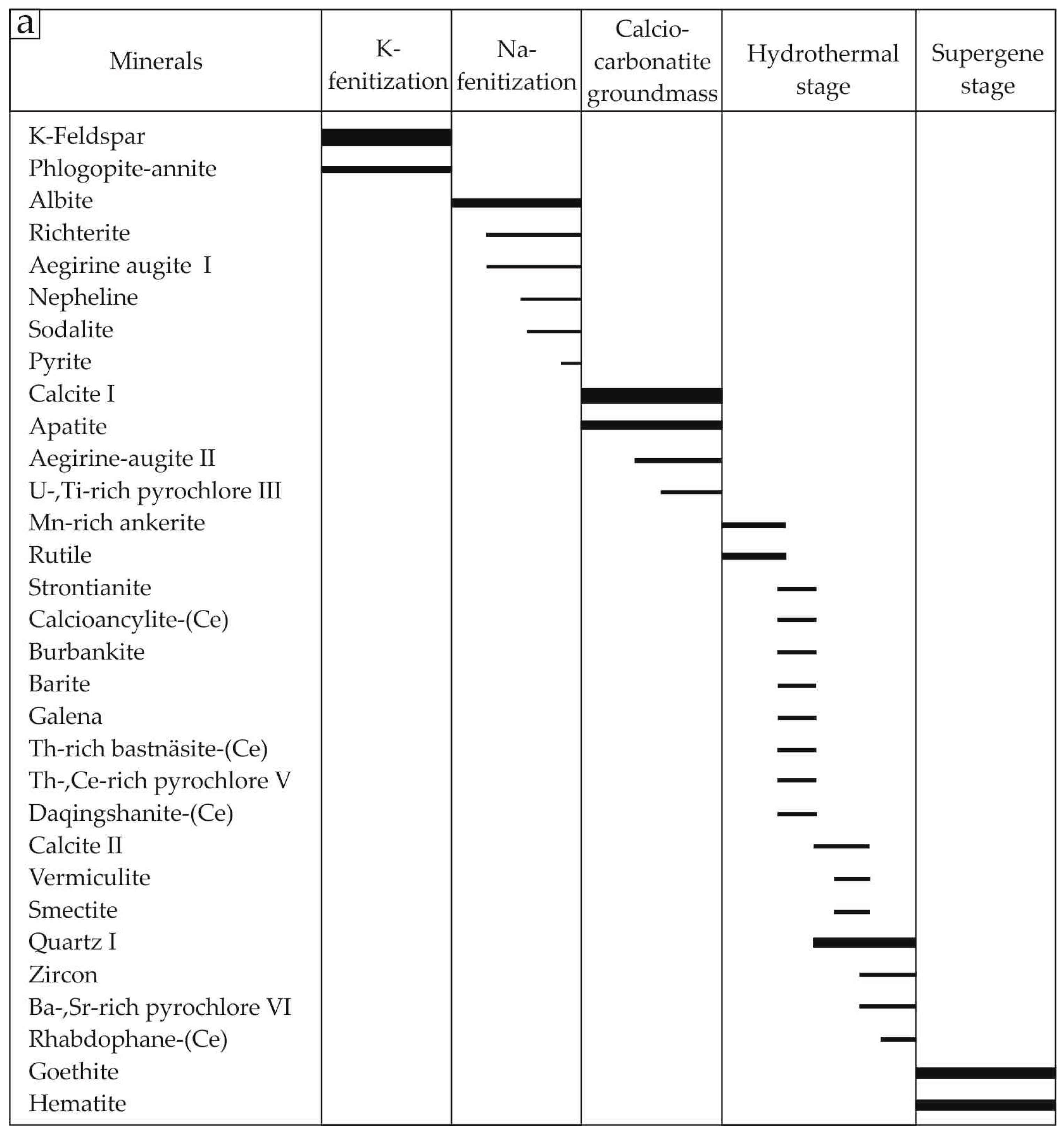
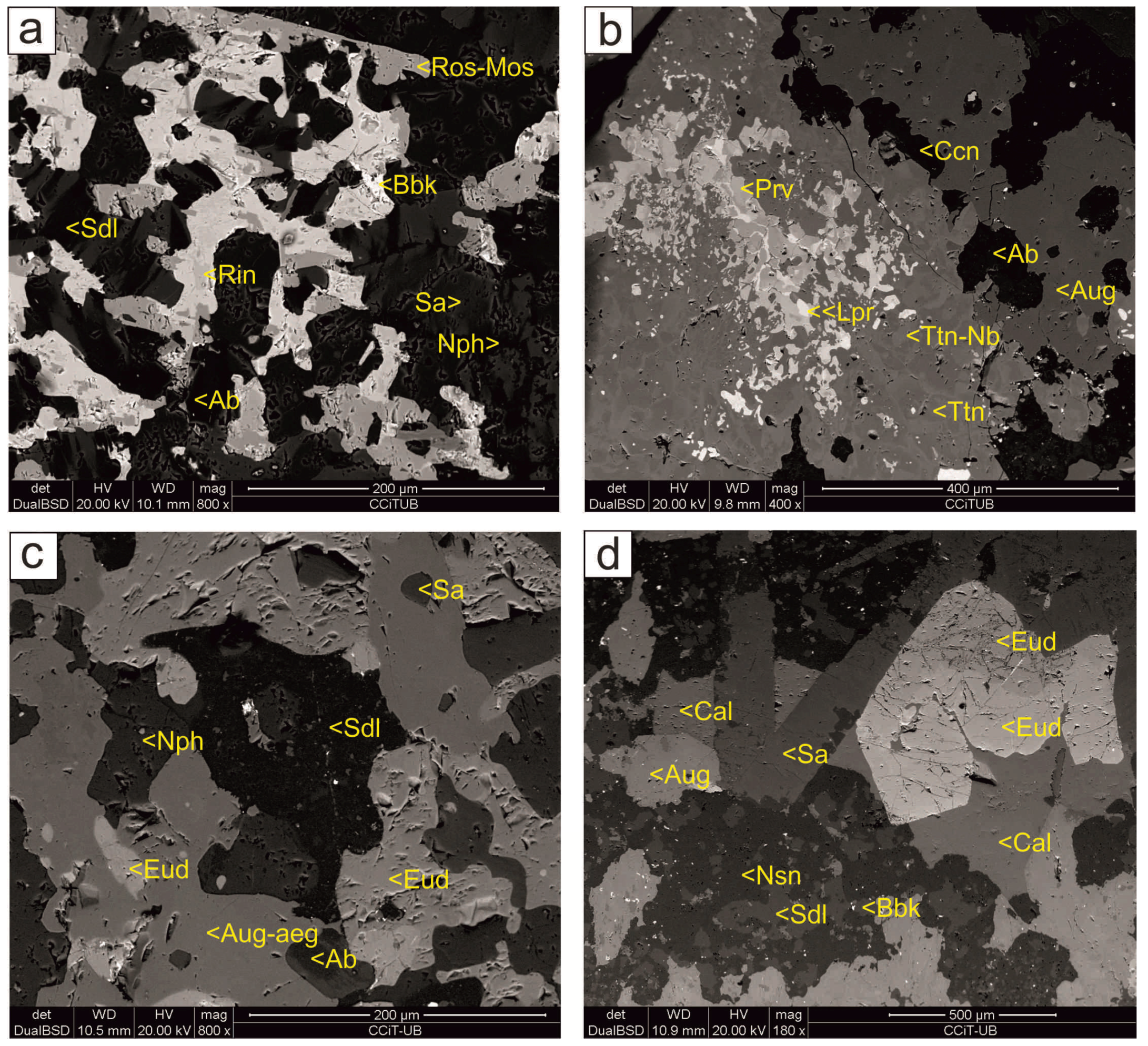
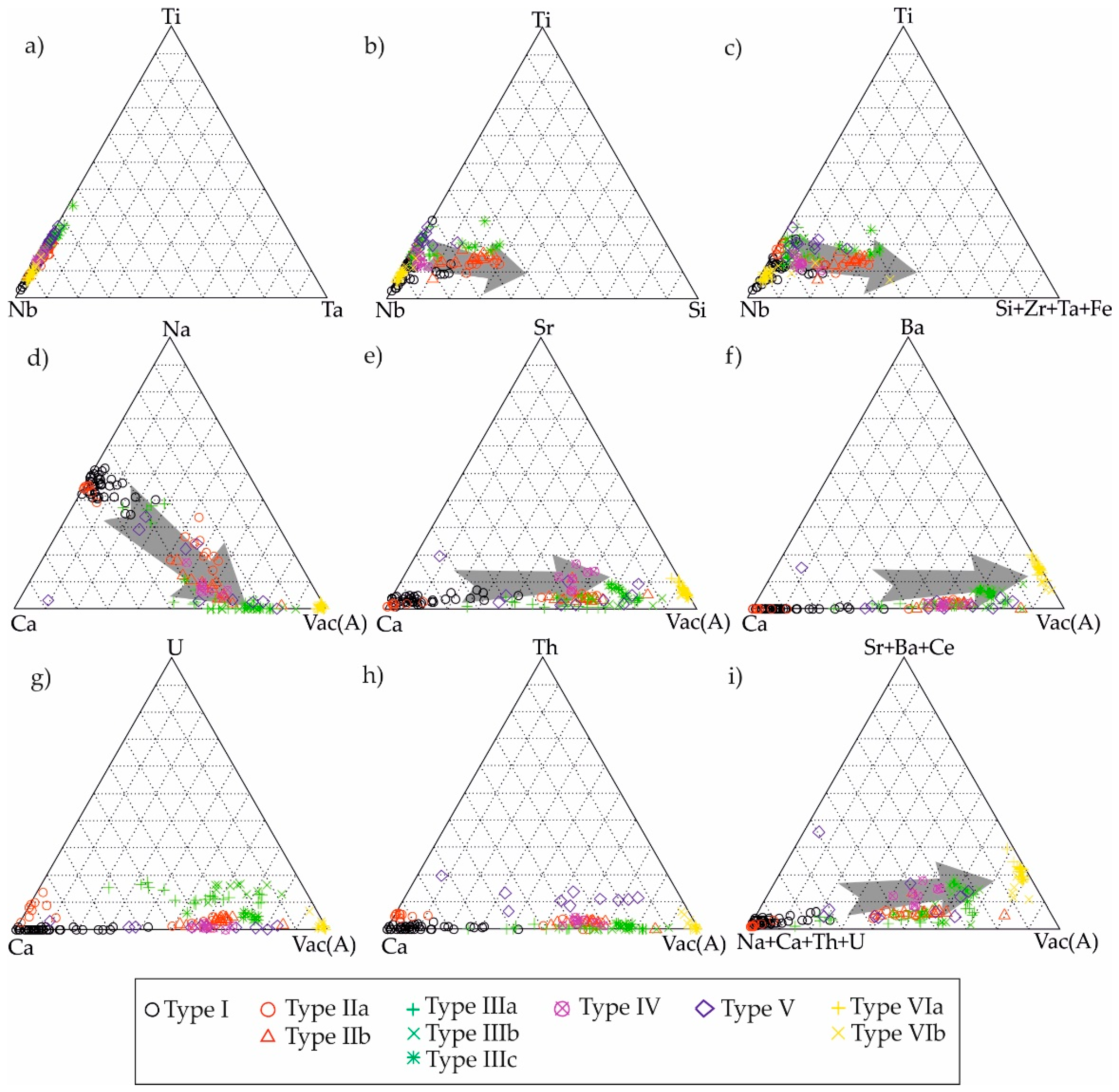
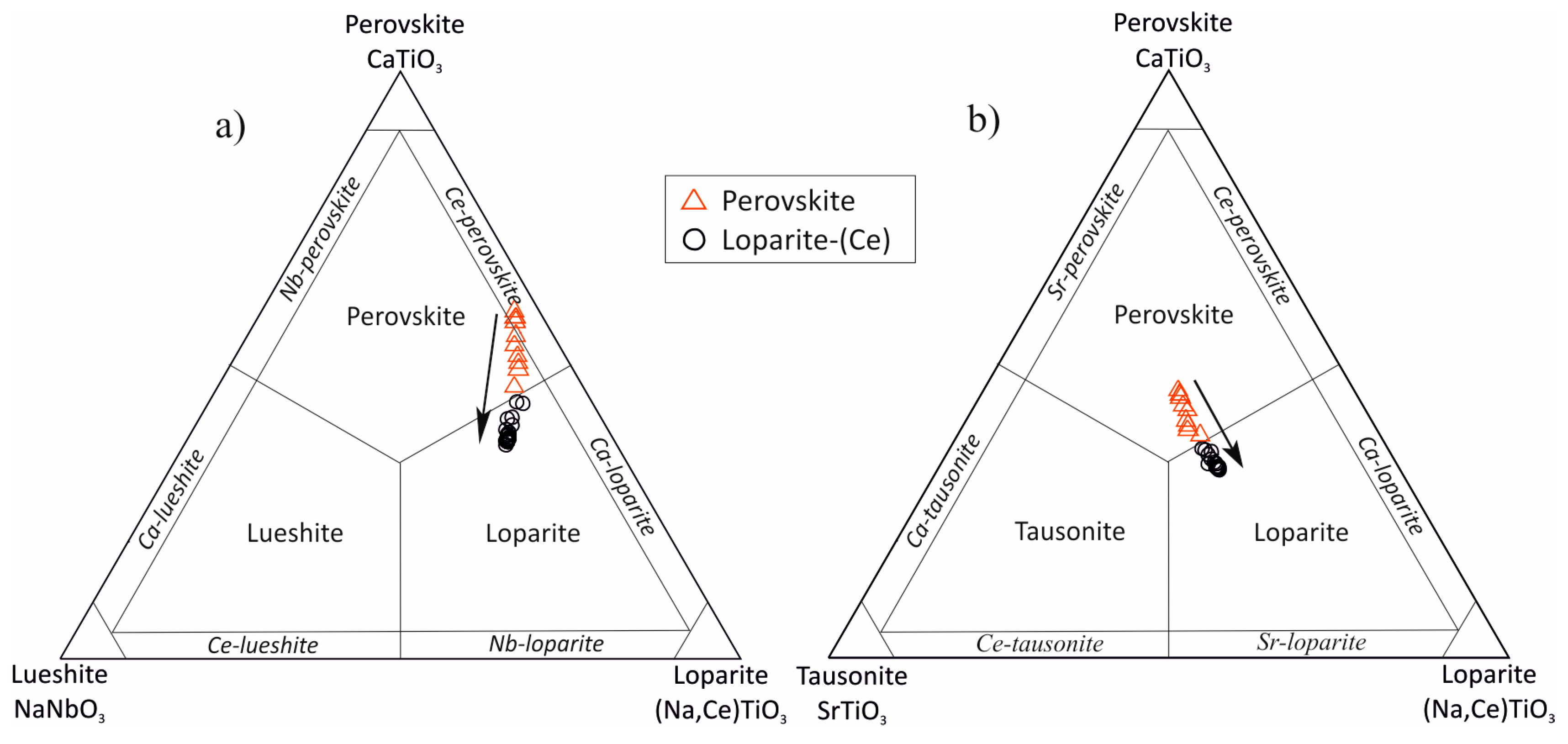
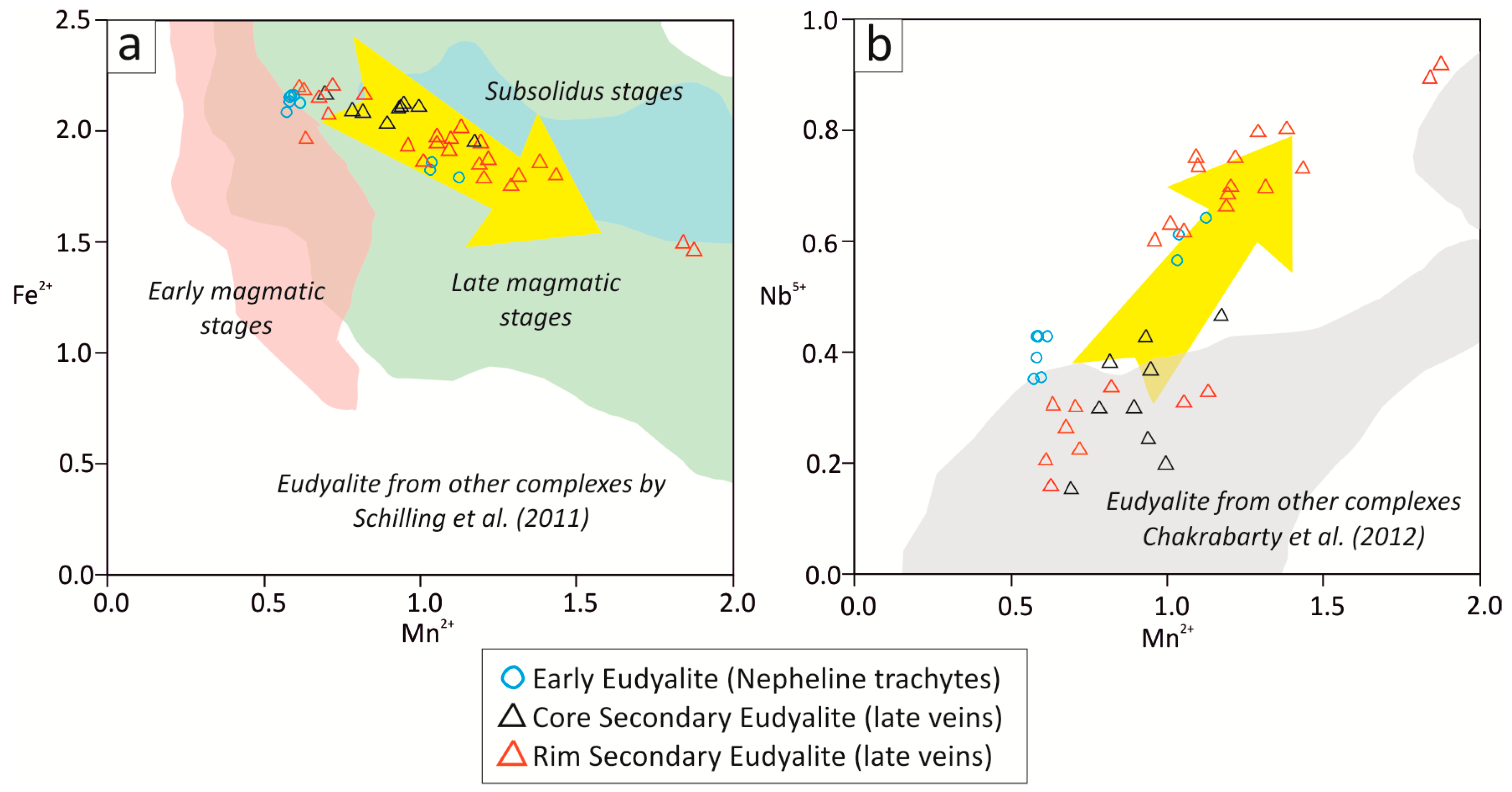
| Pyrochlore and Perovskite-loparite (Element, Standard, X-ray and Crystal) | Na-Ti-Zr Silicates (Element, Standard, X-ray and Crystal) | REE Carbonates and REE Phosphates (Element, Standard, X-ray and Crystal) |
|---|---|---|
| U (UO2, Mβ, PETJ) | Si (Wollastonite, Kα, TAP) | Si (Wollastonite, Kα, TAP) |
| K (Orthoclase, Kα, PETJ) | Al (Corundum, Kα, TAP) | Ce (CeO2, Lα, PETJ) |
| Th (ThO2, Ma, PETJ) | Hf (Hf, Mα, TAP) | La (LaB6, Lα, PETJ) |
| Ti (Rutile Kα, PETJ) | Ti (Rutile Kα, PETJ) | Ba (Barite, Lα, LIFH) |
| La (LaB6, Lα, PETJ) | La (LaB6, Lα, PETJ) | F (Apatite, Kα, TAPH) |
| Ce (CeO2, Lα, PETJ) | Ce (CeO2, Lα, PETJ) | Gd (Gd3Ga5O12, Lβ, LIFH) |
| Al (Corundum, Kα, TAPH) | Mg (Periclase, Kα, TAPH) | Fe (Fe2O3, Kα, LIFH) |
| Mg (Periclase, Kα, TAPH) | Na (Albite, Kα, TAPH) | Sm (REE−3, Lβ, LIFH) |
| Na (Albite, Kα, TAPH) | F (Apatite, Kα, TAPH) | Mn (Rhodonite, Kα, LIFH) |
| Si (Wollastonite, Kα, TAPH) | Ta (Ta, Lα, LIFH) | Nd (REE−4, Lβ, LIFH) |
| F (Fluorite, Kα, TAPH) | Fe (Fe2O3, Kα, LIFH) | Pr (REE−1, Lβ, LIFH) |
| Ba (Barite, Lα, LIFH) | Mn (Rhodonite, Kα, LIFH) | Ca (CaCO3, Kα, PETL) |
| Nd (REE−4, Lβ, LIFH) | Ba (Barite, Lα, LIFH) | U (UO2, Mβ, PETJ) |
| Mn (Rhodonite, Kα, LIFH) | Ca (Wollastonite, Kα, PETL) | Th (ThO2, Ma, PETJ) |
| Sm (REE−3, Lβ, LIFH) | K (Orthoclase, Kα, PETJ) | P (Apatite, Kα, TAPH) |
| Fe (Fe2O3, Kα, LIFH) | Cl (AgCl, Kα, PETL), | Y (YAG, Lα, PETL) |
| Ta (Ta, Lα, LIFH) | Nb (Nb, Lα, PETL) | Sr (Celestine, Lα, PETL) |
| Ca (Wollastonite, Kα, PETL) | Zr (ZrO2, Lα, PETL) | |
| Pb (PbS, Mα, PETL) | Sr (Celestine, Lα, PETL) | |
| Nb (Nb, Lα, PETL) | ||
| Zr (ZrO2, Lα, PETL) | ||
| Sr (Celestine, Lα, PETL) |
| Group | Mineral | Formula | Unit |
|---|---|---|---|
| Tectosilicates | |||
| Quartz | Quartz | SiO2 | Fenites; matrix-supported alkaline breccia |
| Feldspar group | K-feldspar Albite | KAlSi3O8 NaAlSi3O8 | Andradite-bearing nepheline syenite; fenites; matrix-supported alkaline breccia; alkaline dykes |
| Feldspathoid group | Nepheline-kalsilite | (Na,K)AlSiO4 | Foidolites; andradite-bearing nepheline syenite; fenites; matrix-supported alkaline breccia; alkaline dykes |
| Sodalite | Na8(Al6Si6O24)Cl2 | Foidolites; andradite-bearing nepheline syenite; fenites; matrix-supported alkaline breccia; alkaline dykes | |
| Cancrinite | (Na,Ca,☐)8(Al6Si6O24)(CO3,SO4)2∙2H2O | Foidolites; andradite-bearing nepheline syenite; matrix-supported alkaline breccia; alkaline dykes | |
| Phyllosilicates | |||
| Mica group | Phlogopite-tetraferriphlogopite | KMg3(Fe3+Si3O10)(OH,F)2 | Foidolites |
| Phlogopite-annite | K(Mg,Fe2+)3(AlSi3O10)(OH)2 | Foidolites; fenites; matrix-supported alkaline breccia | |
| Inosilicates | |||
| Clinopyroxene group | Aegirine augite | (Ca,Na(Mg,Fe2+Fe3+)(Si2O6) | Foidolites; andradite-bearing nepheline syenite; fenites; breccia carbonatite groundmass; alkaline dykes |
| Diopside | CaMgSi2O6 | Foidolites (ijolites) | |
| Amphibole group | Kaersutite | NaCa2{Mg3AlTi}(Al2Si6O22)O2 | Foidolites |
| Arfvedsonite | NaNa2(Fe2+4Fe3+)Si8O22(OH)2 | Foidolites | |
| Richterite–ferrorichterite | Na(NaCa)(Mg,Fe2+)5Si8O22) (OH)2 | Fenites; calciocarbonatite fragments; matrix-supported alkaline breccia | |
| Cyclosilicates | |||
| Eudialyte group | Eudialyte | Na15Ca6(Fe2+,Mn2+)3Zr3[Si25O73](O,OH,H2O)3(OH,Cl)2 | Alkaline dykes |
| Sorosilicates | |||
| Rinkite group | Rosenbuschite | Na6Ca6Zr3Ti(Si2O7)4O2F6 | Melteigite; alkaline dykes |
| Mosandrite-(Ce) | (Ca3REE)[(H2O)2Ca0.5☐0.5]Ti(Si2O7)2(OH)2(H2O)2 | Alkaline dykes | |
| Rinkite | (Ca3Ce)Na(NaCa)Ti(Si2O7)2(OF)F2 | Melteigite; alkaline dykes | |
| Wöhlerite group | Wöhlerite | NaCa2(Zr,Nb)(Si2O7)(O,OH,F)2 | Andradite-bearing nepheline syenite; alkaline dykes |
| Nesosilicates | |||
| Titanite group | Titanite | CaTi(SiO4)O | Foidolites (urtites, melteigites); alkaline dykes |
| Garnet group | Andradite-schorlomite | Ca3Fe3+2(SiO4)3-Ca3(Ti,Fe3+)2((Si,Fe3+)O4)3 | Foidolites (ijolites); andradite-bearing nepheline syenite |
| Zircon group | Zircon | Zr(SiO4) | Andradite-bearing nepheline syenite; matrix-supported alkaline breccia |
| Britholite group | Britholite-(La), | Ca2(La,Ce,Ca)3(SiO4,PO4)3(OH,F) | Foidolites (melteigite) |
| Britholite-(Ce) | (Ce,Ca)5(SiO4)3OH | Alkaline dykes | |
| Oxides | |||
| Ilmenite group | Ilmenite | Fe2+TiO3 | Matrix supported alkaline breccia; alkaline dykes |
| Oxyspinel group | Ulvöspinel | TiFe2O4 | Foidolites; alkaline dykes |
| Rutile group | Rutile | TiO2 | Fenites; calciocarbonatite fragments |
| Ilmenorutile | Fex(Nb,Ta)2x∙4Ti1−xO2 | Matrix supported alkaline breccia | |
| Diaspore group | Goethite | α-Fe3+O(OH) | Fenites |
| Hematite group | Hematite | Fe2O3 | Matrix supported alkaline breccia |
| Pyrochlore group | Fluornatro-pyrochlore | (Na,Ca)2Nb2O6F | Calciocarbonatite fragments; matrix-supported alkaline breccia |
| Secondary Pyrochlore (II, III, IV, V, VI) | (☐,Ca,Th,U,Ba,Sr,REE)2 Nb2O6(OH,F) | Andradite-bearing nepheline syenite; calciocarbonatite fragments; matrix-supported alkaline breccia; breccia with carbonatite groundmass; alkaline dykes | |
| Perovskite group | Perovskite | CaTiO3 | Alkaline dykes |
| Loparite-(Ce) | (Na,REE)Ti2O6 | Alkaline dykes | |
| Sulphides | |||
| Pyrite group | Pyrite | FeS2 | Fenites; calciocarbonatite fragments; alkaline dykes |
| Galena group | Galena | PbS | Fenites; matrix-supported alkaline breccia |
| Sphalerite group | Sphalerite | ZnS | Matrix supported alkaline breccia |
| Pyrrhotite group | Pyrrhotite | Fe7S8 | Foidolites (urtites melteigite); matrix-supported breccia |
| Pentlandite group | Pentlandite | (FexNiy)Σ9S8 | Foidolites (urtites melteigite) |
| Sulphates | |||
| Baryte | Baryte | BaSO4 | Fenites; calciocarbonatite fragments; matrix-supported breccia |
| Phosphates | |||
| Apatite group | Apatite | Ca5(PO4)3(Cl/F/OH) | Calciocarbonatite fragments; matrix-supported breccia; breccia with carbonatite groundmass |
| Rhapdophane group | Rhabdophane-(Ce) | Ce(PO4)·H2O | Fenites; alkaline dykes |
| Halides | |||
| Fluorite group | Fluorite | CaF2 | Calciocarbonatite fragments; matrix-supported breccia |
| Carbonates | |||
| Calcite group | Calcite | CaCO3 | Melteigite; andradite-bearing nepheline syenite; fenites; calciocarbonatite fragments; matrix-supported breccia; breccia with carbonatite groundmass; alkaline dykes |
| Dolomite group | Ankerite | Ca(Fe2+,Mg)(CO3)2 | Fenites |
| Aragonite group | Strontianite | SrCO3 | Fenites; calciocarbonatite fragments |
| Synchysite group | Synchysite-(Ce) | CaCe(CO3)2F | Melteigite; calciocarbonatite fragments; matrix-supported breccia; alkaline dykes |
| Ancylite group | Ancylite-(Ce)Calcioancylite-(Ce) | CeSr(CO3)2(OH)∙H2O (Ce,Ca,Sr)CO3(OH,H2O) | Fenites; calciocarbonatite fragments; matrix-supported breccia; alkaline dykes |
| Burbankite group | Burbankite | (Na,Ca)3(Sr,Ba,Ce)3(CO3)5 | Calciocarbonatite fragments; matrix-supported breccia; breccia with carbonatite groundmass; alkaline dykes |
| - | Carbocernaite | (Ca,Na)(Sr,Ce,Ba)(CO3)2 | Alkaline dykes |
| Bastnäsite group | Th-rich bastnäsite-(Ce) | Ce(CO3)F | Fenites |
| - | Daqingshanite-(Ce) | (Sr,Ca,Ba)3(Ce,La)(CO3)3−x(PO4)(OH,F)2x | Fenites |
© 2019 by the authors. Licensee MDPI, Basel, Switzerland. This article is an open access article distributed under the terms and conditions of the Creative Commons Attribution (CC BY) license (http://creativecommons.org/licenses/by/4.0/).
Share and Cite
Amores-Casals, S.; Gonçalves, A.O.; Melgarejo, J.-C.; Martí Molist, J. Nb and REE Distribution in the Monte Verde Carbonatite–Alkaline–Agpaitic Complex (Angola). Minerals 2020, 10, 5. https://doi.org/10.3390/min10010005
Amores-Casals S, Gonçalves AO, Melgarejo J-C, Martí Molist J. Nb and REE Distribution in the Monte Verde Carbonatite–Alkaline–Agpaitic Complex (Angola). Minerals. 2020; 10(1):5. https://doi.org/10.3390/min10010005
Chicago/Turabian StyleAmores-Casals, Sandra, Antonio Olimpio Gonçalves, Joan-Carles Melgarejo, and Joan Martí Molist. 2020. "Nb and REE Distribution in the Monte Verde Carbonatite–Alkaline–Agpaitic Complex (Angola)" Minerals 10, no. 1: 5. https://doi.org/10.3390/min10010005
APA StyleAmores-Casals, S., Gonçalves, A. O., Melgarejo, J.-C., & Martí Molist, J. (2020). Nb and REE Distribution in the Monte Verde Carbonatite–Alkaline–Agpaitic Complex (Angola). Minerals, 10(1), 5. https://doi.org/10.3390/min10010005






